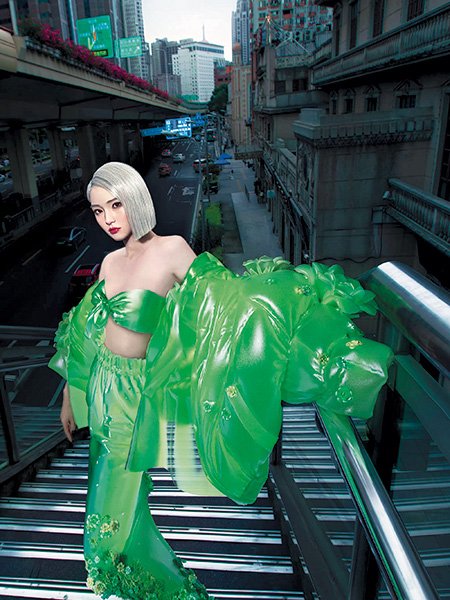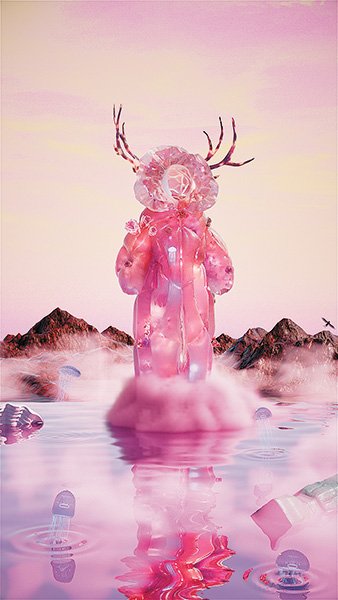January 27, 2023
BEIJING – At school, Miao Sheng’ai is a grade 12 student, busy preparing for her college entrance exam; at home,she designs garments that don’t exist in the physical world.
The “fabric” she uses is not made with thread, but generated by computer, allowing the 18-year-old Tianjin resident to fully let loose her creativity and imagination. In the digital fashion landscape, rules are made to be broken and gravity does not exist.
“With no concerns about textiles or functional needs, I can focus on the visual aspect of my design,” Miao says. She learned to use 3D design software on her own and her unique fashion sense has gained her 19,000 followers on Xiaohongshu, a popular Chinese social media platform.
Already she has garnered interest from an entertainment star. Xu Yangyuzhuo, a member of pop idol group SNH48, recently posted three digitally altered photos on the platform in which she sports Miao’s designs.
Digital fashion is gaining in popularity with the tech-savvy younger generation, who live more and more of their social lives online,and influencers and celebrities are following Xu’s lead, using the new technology to enrapture audiences.
Digital fashion, still a largely unexplored frontier, has grabbed the fashion industry’s attention, and circumstances have also forced a market change. The COVID-19 pandemic, which shuttered or restricted the operations of malls and boutiques around the country,accelerated the pace of digitization.

Virtual clothing design by Sun Fanrui, named Beware.[Photo provided to China Daily]
The concept of the metaverse refers to a network of virtual places linked to a virtual universe, in which people can interact via various forms of virtual technology,including virtual reality and augmented reality.
Companies in China are responding in force to the new opportunities presented by these technologies. During the Spring-Summer China Fashion Week in September, sportswear brand Anta and tech giant Baidu launched a virtual fashion show, displaying Anta’s latest gear.
Social media platforms like Xiaohongshu and Bytedance have also entered the field. Via R-Space, a digital shopping platform, Xiaohongshu users can shop for virtual garments and accessories. Bytedance launched Pheagee, a digital fashion community, early last year.It carries virtual clothing collections from 28 domestic brands.
Customers can not only browse but also try on digital clothes through augmented reality. After paying for digital items on these platforms, they can send a picture of themselves and wait to receive a photo in which they are wearing the virtual pieces. The photo can then be posted on social media.
Prices are customer-friendly, ranging from a few dozen to a few hundred yuan. The designs Miao sells on R-Space usually cost 89 yuan($13.12) for two photos.
Digital fashion is here to stay, satisfying increasing demand for self-expression online. As one Xiaohongshu fashion blogger,named Kira Qiya, explains in a post to her 113,000 followers, “by getting rid of all the rules of reality and the limitations of textiles, digital fashion has opened a brand-new world for my wearing experience”.
She owns 54 virtual clothes and accessories on R-Space, including an iridescent dress with butterfly wings, a shimmering tutu which makes her look like she is wearing water, a futuristic headpiece and a handbag with a beating heart.

A model “wears” virtual clothing designed by Chen Peng.[Photo provided to China Daily]
Going virtual
After COVID-19 put face-to-face activities like shows on hold, an increasing number of designers turned to the metaverse as the place to display their collections.
Designer Chen Peng, who founded his namesake brand in 2015, collaborated last year with digital artist Uv Zhu, releasing a digital fashion collection consisting of six super-sized puffer jackets, intended to provoke thought as well as sales.
“In this collection, we try to discuss what clothing will look like in the metaverse and what its function will be,” Chen says, adding that in the metaverse, clothing becomes a part of a person’s body, like skin or muscle, growing with them over time.
“It is different from traditional clothing, which is used for warmth and modesty, in that designers can focus purely on visual effects and design expression,” he says. “It can help designers be more creative and artistic.”
The pieces in Lemuria, a digital collection of Chen’s displayed on Pheagee, sell for 599 yuan each. His style is much the same in his physical and digital designs. He defines it as “one-sized fashion”, speaking for all body types.
Chen urges designers to try new methods to lure the younger generation and prepare for the future. He is considering participating in the upcoming Metaverse Fashion Week on virtual reality platform Decentraland, set to be held in late March.
Chen is just one of a new generation of virtual artists from China who have made their mark in the digital fashion industry.
Sun Fanrui started her exploration in digital fashion in early 2020 while studying for a bachelor’s degree in fashion at the Lu Xun Academy of Fine Arts in Northeast China’s Liaoning province. Last year, she enrolled in the Royal College of Art in London for a master’s degree in fashion. Her whimsical digital creations are popular on overseas digital fashion platforms,such as XR Couture and Xtended Identity.
“In digital fashion, designers can create unlimited designs in a fast and easy way,” Sun says. “In today’s world, people like to express themselves through different mediums.Virtual clothing provides a new form of self-exploration and self-presentation in cyberspace.”
Her virtual designs are inspired in large part by ocean animals, and look alien and ultramodern. In her eyes, digital fashion opens up new possibilities.
Sun, with a background in traditional fashion design, says digital fashion has helped her to push the boundaries of textile and structure.She hopes to transfer the insights gained to her real-world fashion designs.
“With the rise of digital fashion,more and more are joining the industry, more work will be displayed and everyone will have a chance to write the new chapter of digital fashion together,” she adds.
Universities and design schools are busy preparing the new generation of fashion designers for this exciting frontier. In November, the first China Metaverse Fashion Design Competition was launched in Wuhan, Hubei province. Developed by tech company Zettakit, it featured students from more than 20 fashion and art education institutions.

Sun Fanrui’s design, named Qi.[Photo provided to China Daily]
The metaverse, with all of its potentialities, has also proven a challenge to govern, and problems have appeared like real estate speculation, virtual currency scams and copyright disputes.
According to Morgan Stanley,Chinese regulators are “increasing focus on minors’ addiction, personal information protection, data security, and openness of ecosystem”, though mainstream adoption of the metaverse will “take a long time, given major technological and regulatory hurdles.”
Designers and entrepreneurs in the digital fashion world agree that,since the industry is in its infancy,and given that there are relatively few cost or technological barriers to becoming a digital fashion designer,more regulation is necessary to guarantee high quality and good services. However, they remain optimistic about its future.
Xing Ziqi, co-founder of London-based brand Xtended Identity -which aims to extend human identity beyond traditional limitations in an innovative, boundary-free way -says that “the global pandemic starting in 2020 made digital fashion mainstream, and we have been creating digital fashion in the metaverse since then. From my observation, digital fashion is a hot concept in China, welcomed by customers and designers”.
She predicts that in the future,everybody will have digital clothing displayable on social media, in video calls, at online conferences and in other virtual scenarios.
Fashion is the most widely adopted digital commodity not only in China, but across the world, according to a study conducted last year by Virtue Worldwide, a creative agency owned by American-Canadian digital media and broadcasting company Vice. Virtue Worldwide’s survey of 3,000 consumers found that virtual goods are no longer considered niche purchases. A total of 94 percent of respondents see digital fashion becoming mainstream.
Nor are digital pieces restricted to the low-end market. Some are going for prices these days that rival those of the haute couture fashion world.Last year, Xtended Identity sold a dress on virtual goods marketplace The Dematerialised for $6,100.
Designers have grand, science fiction-esque visions for the future of digital fashion. Xing Ziqi and her co-founder Xing Yunjia predict that digital and physical fashion will eventually intermingle. They call this “phygital”.
“It refers to a garment that consists of digital parts and physical parts that form a complete look,which will be the key innovation in our next collection design. The beauty of combining the digital and the physical is that it pushes people’s fashion experience beyond reality,”says Xing Ziqi.

A digital fashion collection released by designer Chen Peng and digital artist Uv Zhu.The collection explores the potentialities of clothing in the metaverse.[Photo provided to China Daily]

A digital fashion collection released by designer Chen Peng and digital artist Uv Zhu.The collection explores the potentialities of clothing in the metaverse.[Photo provided to China Daily]

A design from Lemuria, a collection Chen is displaying on digital fashion platform Pheagee. His style is much the same in his physical and digital designs. He defines it as “one-sized fashion”, speaking for all body types.[Photo provided to China Daily]

A design from Lemuria, a collection Chen is displaying on digital fashion platform Pheagee. His style is much the same in his physical and digital designs. He defines it as “one-sized fashion”, speaking for all body types.[Photo provided to China Daily]

A design from Lemuria, a collection Chen is displaying on digital fashion platform Pheagee. His style is much the same in his physical and digital designs. He defines it as “one-sized fashion”, speaking for all body types.[Photo provided to China Daily]

A design from Lemuria, a collection Chen is displaying on digital fashion platform Pheagee. His style is much the same in his physical and digital designs. He defines it as “one-sized fashion”, speaking for all body types.[Photo provided to China Daily]


